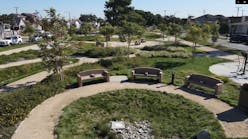EPA Proposes Plan for Next Phase of Cleanup at Three New Jersey Superfund Sites
The U.S. EPA is proposing a cleanup plan to address water bodies of the Sherwin-Williams/Hilliards Creek Site in Gibbsboro, Lindenwold, and Voorhees, New Jersey.
The proposed plan calls for dredging contaminated sediment, along with the excavation and capping of floodplain soil at Silver Lake, Bridgewood Lake, Kirkwood Lake, and Hilliards Creek, reported EPA.
“The cleanup of these water bodies has long been sought by these communities and we are proud of this proposal,” said EPA Acting Regional Administrator Walter Mugdan in the EPA press release. “The proposed cleanup addresses arsenic and lead contamination that poses serious risks to people, fish and wildlife.”
There are three Sherwin-Williams Superfund sites that are sources of contamination to the water bodies, located within the municipalities of Gibbsboro, Voorhees, and Lindenwold, New Jersey. According to EPA, contamination from past paint manufacturing originates within the area of the Former Manufacturing Plant (Sherwin-Williams/Hilliards Creek Superfund Site), the Route 561 Dump Site, and the U.S. Avenue Burn Superfund Site.
As a result, the source areas are being cleaned up and contaminants from these three sites have moved downstream throughout the lakes and creeks within Gibbsboro, Voorhees and Lindenwold.
The proposed plan calls for the dredging of 128,000 cubic yards of contaminated sediment from Silver Lake, Bridgewood Lake, Kirkwood Lake, and Hilliards Creek and includes the construction of a system to temporarily divert streams during the cleanup. EPA proposes to remove approximately 42,000 cubic yards of the top two feet of soil located within the floodplain areas and cap contaminated soil below two feet.
In addition, the proposed plan provides for treatment, transport and disposal of excavated sediment and soil at a permitted facility that is off-site, as well as the implementation of deed notices.
While the proposed cleanup occurs, EPA will monitor and study the cleanup progress, conducting a review of the cleanup every 5 years. Under the proposed plan, the estimated cost of this cleanup is approximately $90 million, reported EPA.
A 30-day public comment period for the proposed plan will occur from Apr. 1 to May 3, 2021. EPA will host a Virtual Public Meeting on Apr. 12, 2021 at 7:00 p.m. To register for the public meeting, visit https://epa-sherwin-williams-ou4.eventbrite.com and to learn more about the public meeting, contact Pat Seppi at [email protected] or 646-369-0068.






